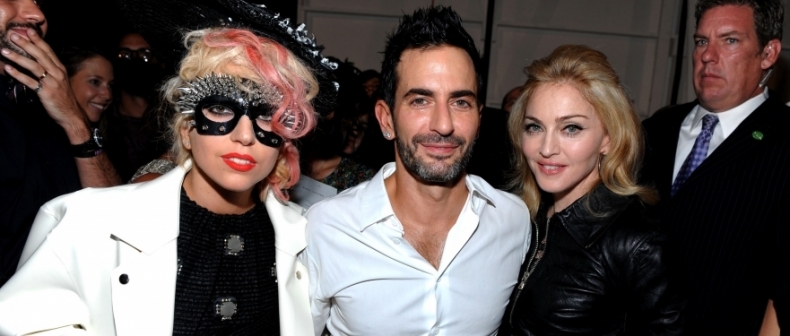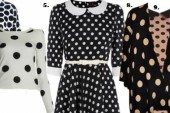
What happens when Marc by Marc Jacobs is no longer actually by Marc Jacobs? That’s the obvious question after vice president Robert Duffy, Jacobs’ financial partner since 1984, informed Women’s Wear Daily the designer would step down as creative director of the diffusion line he started in 2001. Why did Duffy make the announcement and not Jacobs himself? You could hardly call the designer media-shy–he recently lent his face (and buff torso) to a Diet Pepsi ad campaign. “We rested our laurels and it hurt us,” Duffy confessed, describing the once-hip label as “a little stale.”
“He’s still the boss,” he said of Jacobs. “He’s as involved as he wants to be. It depends on the season.” That’s a bit vague. The company has hired Kate Hillier to oversee the makeover and designer Luella Bartley, who previously revived the British brand Mulberry. For fashion followers with memories that stretch farther back than one season, the irony is as heavy as a Louis Vuitton suitcase–the designer who successfully revived other people’s labels is backing away from his own. With two other lines to focus on, Jacobs may be happy with taking a break from this one. Designers rarely design their diffusion lines, so it’s possible not much will change. But if for the brand to regain its trendsetter status, Bartley and Hillier will have to figure out what Marc sans Marc is all about.
The company Perry Ellis faced a similar dilemma after the death of its founder in 1986, most likely from complications from HIV/AIDS. The designer, known for his sporty, modern take on American classics, kept his illness hidden, touchingly walking down the runway even when he was so weakened he needed the help of assistants on each arm.
The young Marc Jacobs won the Council of Fashion Designers of America‘s Perry Ellis Award for “New Fashion Talent” the following year, so it seemed a perfect fit when Jacobs joined forces with Perry Ellis the year after that. He brought a much-appreciated freshness to the women’s line. In 1992, the Council awarded him Women’s Designer of the Year. Few designers have been as feted by the industry as Jacobs despite (if not because of) his continual financial difficulties. Also in 1992, Jacobs showed a collection inspired by the raw, gritty Seattle music scene. The ‘Grunge’ show, featuring luxurious silk shirts designed to look like flannel, was a critical success, but a commercial flop and led to Jacobs’ dismissal from the company. No matter–the collection is now part of fashion history and paved the way for Jacobs’ insanely fruitful revamp of Louis Vuitton.
As with Perry Ellis and Marc Jacobs, before there was Louis Vuitton the company there was Louis Vuitton the man. Prior to the 1850’s, most travel luggage featured rounded, cathedral-like tops to promote water run-off. Parisian businessman Vuitton designed flat-topped pieces that you could stack and forever changed how luggage was made. Competitors ripped off the design so frequently, Vuitton placed his name as a trademark over the brown and beige canvas. (It was only the beginning of the company’s travails with knock-offs.)
Fast forward to 1997–the owners of Louis Vuitton took one of the greatest risks in fashion history and hired Jacobs to spearhead the company’s first foray into ready-to-wear clothing. Treating the classic ‘LV’ logo as Andy Warhol treated Marilyn Monroe’s face, Jacobs gleefully turned it into pop art wallpaper with graffiti, garish graphics, and cartoon colours. Canny partnerships with artists as varied as Sofia Coppola, Takashi Murakami, and Kanye West kept the label in the news. Business quadrupled. Louis Vuitton purses inspired a sort of ‘tulip mania’ economic bubble–it didn’t matter how expensive, tacky, or easy to rip off they were, they reliably flew off the shelves. For a Murakami exhibit, Jacobs hired people to pose as street vendors and hock authentic Louis Vuitton purses in lieu of fake ones.
“Jacobs’ vision has transformed the luxury-goods market,” wrote Ariel Levy in an excellent profile for the New Yorker. “You can feel the reverberations of his early inspiration that a sloppy flannel shirt could be rendered in fine silk, that the low could be high, and that streetwear could be fashion, in everything from the advent of the now ubiquitous two-hundred-dollar pair of jeans to the frayed hems and distressed elbows on the jackets that Karl Lagerfeld has designed for Chanel in recent seasons.”
He did this all while spreading the company’s presence in Asia and expanding his two eponymous labels (Marc Jacob and Marc by Marc Jacobs), the latter he intended specifically for trendy, young women without the disposable income of their mothers. Just as dramatic was the designer’s physical transformation. Once a pale, long-haired bespectacled outsider, after two stints in rehab Jacobs is now a health nut–a tanned and tattooed Olympian god. Compared with the meek young man of early backstage interviews, the confident Jacobs, filmed explaining his kilt to Jimmy Fallon, seems like a whole different person.
Levy wrote that the two figures most responsible for transforming New York’s West Village are Marc Jacobs and Carrie Bradshaw. (You could expand the idea and argue those two figures are equally responsible for spreading a distinctive Manhattan chicness, or an illusion of it, around the globe.) “Carrie Bradshaw, of course, is make-believe,” he said. “Whereas Marc Jacobs is a real person. Or he was once.”
Which is to say, through his influence on the industry and sheer ubiquity in popular culture, Marc Jacobs is as much an idea as a man. That’s instructive for Kate Hillier and Louella Bartley as that’s how they now must think of him. That’s what John Galliano had to do for Christian Dior, and Bill Gaytten is now doing for John Galliano. If properly inspired, a new guard can revive an established label indefinitely, though fashion history is littered with houses that couldn’t survive the departure of their founder.
Throughout his career, Jacobs embraced a kaleidoscope of influences. He made his name initially by reviving looks from the 1960’s and 1970’s with witty details like handprints and smiley faces. His lifting of ideas has not been without controversy–Oscar de la Renta accused Jacobs of ripping off one of his jackets, and he had to apologize for directly copying a Swedish scarf from the 1950’s.
“Probably better than any designer at work, Mr. Jacobs… comprehends something fundamental about changes in how people make, and understand, fashion,” Guy Tremblay wrote in the New York Times. “Unlike the many brand-name designers who promote the illusion that their output results from a single prodigious creativity, Mr. Jacobs makes no pretense that fashion emerges full blown from the head of one solitary genius.” Rather, he is a sampler of what surrounds him and all that came before.
Perhaps that’s the legacy Jacobs leaves for his successors at Marc by Marc Jacobs–not an innovative suitcase, but the fashion designer as postmodern remixer. To paraphrase Marshall McLuhan, it’s not the medium that’s the message. It’s the Marc.
____
Max Mosher writes about style for Toronto Standard. You can follow him on Twitter at @max_mosher_.
For more, follow us on Twitter @TorontoStandard or subscribe to our newsletter.














